Department of Life Sciences, University of Calicut, Malappuram District, Kerala, India, 673635
Corresponding author Email: bsharik111@gmail.com
Article Publishing History
Received: 15/07/2019
Accepted After Revision: 18/09/2019
Starch is the most common carbohydrate in human diets and is contained in large amounts in potatoes, wheat, corn, rice, and cassava. Starch granules are highly variable in their structure, and each has unique structure depending upon their botanical source. In this study, starch was isolated from the stem of pineapple plant at different growth stages-3 months (before flowering), six months (before flowering), nine months (before flowering), 12 months (after flowering), 15 months (after flowering), 18 months (after fruiting). X-ray diffraction (XRD) studies and scanning electron microscopic (SEM) analysis were carried out on these samples as part of characterization studies. Results indicate that maximum starch yield obtained from plant stem at nine months age. X-ray diffraction data revealed this plant stem possess A-type crystals and is same in all growth stages. Size of the granules slightly increased with growth stages and have irregular polygonal in shape. Characterization studies on starch will help assess their specific use in both food and non-food industries.
Pineapple plant, SEM, starch, stem, XRD.
Rinju R, Thampi B. S. H. Characterization Studies on Starch Extracted from the Stem of Pineapple Plant (Ananas comosus) at Different Growth Stages. Biosc.Biotech.Res.Comm. 2019;12(3).
Rinju R, Thampi B. S. H. Characterization Studies on Starch Extracted from the Stem of Pineapple Plant (Ananas comosus) at Different Growth Stages. Biosc.Biotech.Res.Comm. 2019;12(3). Available from: https://bit.ly/2l0d2Ch
Copyright © Rinju and Thampi, This is an open access article distributed under the terms of the Creative Commons Attribution License (CC-BY) https://creativecommns.org/licenses/by/4.0/, which permits unrestricted use distribution and reproduction in any medium, provide the original author and source are credited.
Introduction
The pineapple (Ananas comosus) is a tropical plant and most economically significant plant in the Bromeliaceae family. Starch is the most abundant biomolecule on earth after cellulose and the major carbohydrate reserve in plants. Demand for native starches increased globally as it can minimize the use of chemically modified starches. Native starches have many applications in the food industry, pharmaceutical industry, paper making industry, cosmetics industry, etc. X-ray diffraction is a valuable tool for the structural elucidation of starch granules and is used to study the crystalline properties of starches. Starch crystallinity is due to the formation and packing of double helix between the chains of amylopectin molecules ( Lawal, 2004, Diop et al., 2011).Scanning electron microscopy (SEM) is a frequently used technique for granular characterization of starches and can be used for studying the granule morphology more accurately than light microscopy (Chmelik et al., 2001,Lindeboom et al., 2004). Surface characteristics of granules have many practical applications as it influences the enzyme actions.The enzyme action on starch granules largely determines the quality of starch-based food products, (Kowsik and Mazumder, 2018).
Viscosity, one of the main physical properties of starches, is influenced mainly by their granule morphology (Kumar and Khatkar, 2017). The objective of the study is to characterize the starch from the pineapple plant stem at various growth stages. This study helps to check whether there is any difference in the morphological and crystalline structure of the starch granules with age. The results could serve as a reference for identifying starch from the stem at a particular growth stage to choose in the specific starch industry.
Material and Methods
Extraction of starch
The stem was collected from the experimental plantation at different growth stages – three months, six months, nine months (before flowering), twelve months, fifteen months (after flowering) and eighteen months (after fruiting). It was then washed with water and mild acid to remove soil, and other debris and starch were extracted. The stem was then ground in a mixer grinder with distilled water and filtered through double-layered cheesecloth. The steps were repeated for several times until the milkiness of the slurry disappeared or became minimal, centrifuged and discarded the supernatant. The residues obtained were washed with 60% alcohol, 0.1N NaOH, and distilled water. The retained residues were dried at 40 ºC, powdered and passed through a standard sieve (75µm), collected and stored in desiccators.
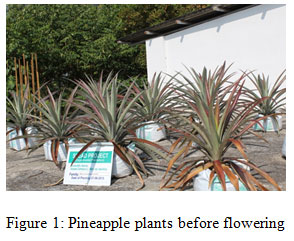 |
Figure 1: Pineapple plants before flowering |
 |
Figure 2: Pineapple plants after flowering |
 |
Figure 3: Pineapple plants after fruiting |
Scanning electron microscopic analysis
The surface and structure of starch samples were characterized using a scanning electron microscope (Carl-ZEISS Gemini SEM 300), using a secondary electron detector with 2.00 kV of acceleration ( Central Sophisticated Instrumentation Facility (CSIF), University of Calicut, Kerala, India).
X-ray diffraction
X-ray diffraction studies on stem starch were carried out by an X-ray diffractometer (Model-XRD- Rigaku Miniflex 600).
Statistical analysis
Microsoft Office Excel 2007 and OriginPro 8.0 were used to analyse the experimental data.
Results and Discussion
The maximum starch yield obtained from the stem at nine months age (before flowering stage). After that yield decreased and then there is almost constant starch content observed. Because of shoot extension growth, utilization of photosynthate increases which causes lower carbohydrate availability for storage and starch content will decrease (Von Fircks and Sennerby-Forsse, 1998).
Table 1: Starch yield at different growth stages of the pineapple plant
| Sl. No. | Age of the plant | % of starch obtained |
| 1 | 3months (Before flowering) | 3.93 ± 0.52 |
| 2 | 6months (Before flowering) | 8.4 ± 0.68 |
| 3 | 9months (Before flowering) | 16.03 ± 0.84 |
| 4 | 12months (After flowering) | 11.56 ± 0.53 |
| 5 | 15months (After flowering) | 11.58 ± 0.44 |
| 6 | 18months (After fruiting) | 11.08 ± 0.77 |
Three months old plant showed peaks at 2θ angles 14.91, 18.3 and 23.7 (Fig: 4), six months old plant had peaks at 2θ angles 15.25, 17.63 and 23.06 (Fig:5), nine months old plant showed at 14.91, 17.30 and 23.40 (Fig:6). Starch from 12 months old plant showed major peaks at 2θ angles 15.16, 17.25 and 23.2 (Fig: 7). Fifteen months have peaks at 14.91, 17.30 and 23.06 (Fig: 8), 18 months have 15.4, 17.26 and 23.21 (Fig: 9). There are A, B and C type starches according to the packing of amylopectin double helices. ‘A’ type starch granule shows peaks around 15º, 17º, 18º, 20º and 23º 2θ angles, ‘B’ type granules shows around 5º, 15º, 17º, 20º, 22º and 24º 2θ angles and C type starch has the mixture of A and B (Zhou, Wang, Zhao, Fang, & Sun, 2010), (Nwokocha, Nwokocha, & Williams, 2012).
‘A’ type starches are mostly found in cereal starches. B type in the tuber and root starches and C type, which is the mixture of A and B, found in particular root, legume, and seed starches. The packing of the helix in A type starch is more compact and less hydrated than B type (Wang et al., 2011) (Guimarães, Wypych, Saul, Ramos, & Satyanarayana, 2010) (Delcour et al., 2010). From the result obtained, it can be concluded that this stem starch possesses ‘A’ type crystals, and it is same in all the growth stages.
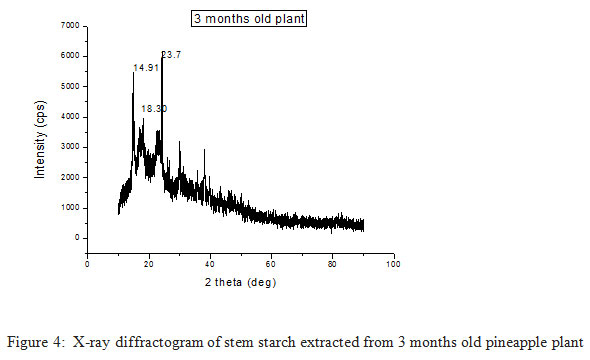 |
Figure 4: X-ray diffractogram of stem starch extracted from 3 months old pineapple plant |
 |
Figure 5: X-ray diffractogram of stem starch extracted from 6 months old pineapple plant |
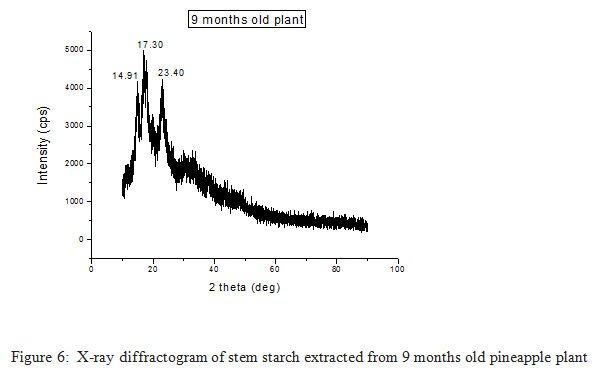 |
Figure 6: X-ray diffractogram of stem starch extracted from 9 months old pineapple plant |
 |
Figure 7: X-ray diffractogram of stem starch extracted from 12 months old pineapple plant |
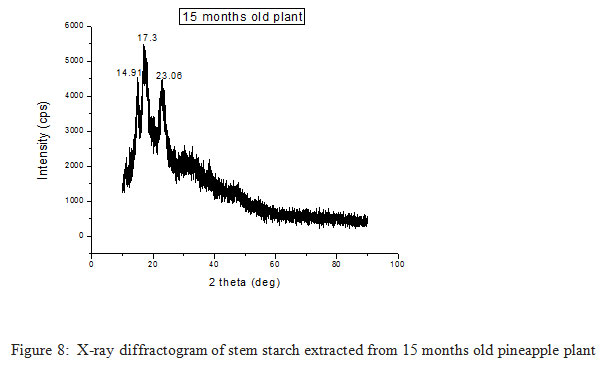 |
Figure 8: X-ray diffractogram of stem starch extracted from 15 months old pineapple plant |
 |
Figure 9: X-ray diffractogram of stem starch extracted from 18 months old pineapple plant |
Fig. 10-15 shows the SEM photographs of the stem starch at their different growth stages. The analysis revealed that there is no uniform distribution in granule size and shape. An increasing trend was observed in granule size with age. The shape is mainly polyhedral; surfaces are smooth, and round-shaped granules are also present. This observation is the same in all the observed stages of plant growth. These types of granules can be seen in the tuber and root starches (Hoover, 2001) (Lindeboom et al., 2004).
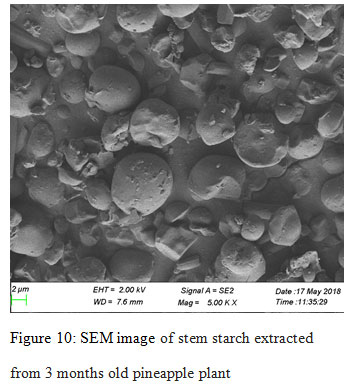 |
Figure 10: SEM image of stem starch extracted |
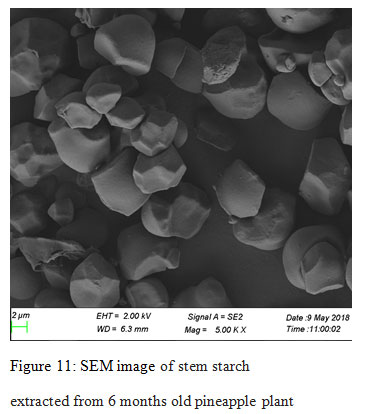 |
Figure 11: SEM image of stem starch extracted from 6 months old pineapple plant |
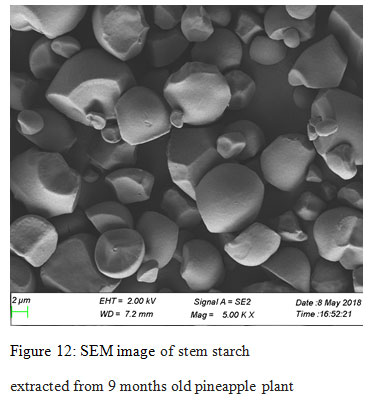 |
Figure 12: SEM image of stem starch extracted from 9 months old pineapple plant |
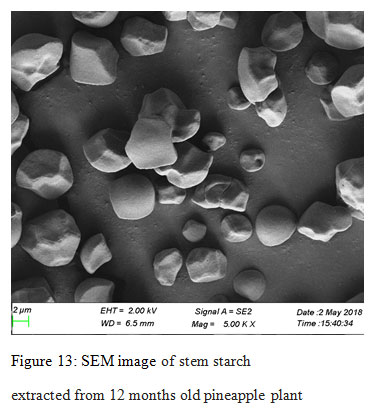 |
Figure 13: SEM image of stem starch extracted from 12 months old pineapple plant |
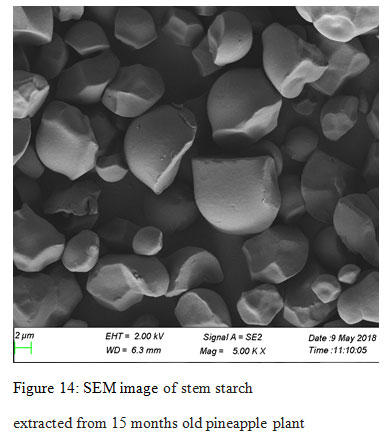 |
Figure 14: SEM image of stem starch extracted from 15 months old pineapple plant |
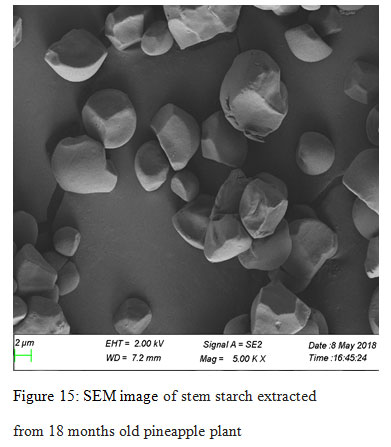 |
Figure 15: SEM image of stem starch extracted |
Table 2: Size of starch granules at different growth stages
| Age of the plant | Size of the starch granules (µm) |
| 3months (Before flowering) | 1-7 |
| 6months (Before flowering) | 1.2-7 |
| 9months (Before flowering) | 1.5-8 |
| 12months (After flowering) | 2.8-7 |
| 15months (After flowering) | 2.2-8.5 |
| 18months (After fruiting) | 3-7 |
Conclusion
The pineapple plant stem has a varying concentration of starches with growth and maximum starch yield obtained at nine months age. After that the yield decreased and then there is no considerable change in starch content. XRD analyses revealed this stem starch have A-type starch granules in all the growth stages. SEM study indicates that the starch granules are irregular polygonal in shape with a smooth surface. There is a slight increase in granule size with age. The results of this research provide useful information about the characters of pineapple plant stem starch at their different growth stages. These data can enhance their application in various starch industries as a substitute for commercially available starches.
Acknowledgements
Western Ghats Development Cell under the State Planning and Economic Affairs Department (G.O.(MS)No.51/14/Plg. Dated 04/12/2014), Govt. of Kerala, India and Central Sophisticated Instrumentation Facility (CSIF), University of Calicut, Kerala, India.
References
Chmelik J, Krumlova A, Budinska M, and Kruml T, Psota V, Bohacenko I, Mazal P, Vydrova H, (2001), Comparison of Size Characterization of Barley Starch Granules Determined by Electron and Optical Microscopy, Low Angle Laser Light Scattering and Gravitational Field-Flow Fractionation, Journal of The Institute of Brewing, Vol 107, No. 1: Pages 11-17.
Delcour J A, Bruneel C, Derde L J, Gomand S V, Pareyt B, Putseys J A, Wilderjans E, and Lamberts L, (2010), Fate of starch in food processing: from raw materials to final food products, Annual review of food science and technology, Vol 1: Pages 87–111.
Diop C I K, Li H L, Xie B J, Shi J, (2011), Effects of acetic acid/acetic anhydride ratios on the properties of corn starch acetates, Food Chemistry, Vol. 126: Pages 1662–1669.
Hoover R, (2001), Composition, molecular structure and physicochemical properties of tuber and root starches: a review, Carbohydrate polymers, Vol 45: Pages 253-267.
Kowsik P V, Mazumder N, (2018), Structural and chemical characterization of rice and potato starch granules using microscopy and spectroscopy, Microscopy Research and Technique, Pages 1-8.
Lawal O S, (2004), Composition, physicochemical properties and retro gradation characteristics of native, oxidised, acetylated and acid-thinned new cocoyam (Xanthosoma sagittifolium) starch, Food Chemistry, Vol. 87: Pages 205–218.
Lindeboom N, Chang P R, Tyler R T, (2004), Analytical, Biochemical and Physicochemical Aspects of Starch Granule Size, with Emphasis on Small Granule Starches: A Review, Starch/Starke, Vol. 56: Pages 89–99.
Nwokocha L M, Kate E. Nwokocha K E and Williams P A, (2012), Physicochemical properties of starch isolated from Antiaris africana seeds in comparison with maize starch, Starch/Starke, Vol 64: Pages 246–254.
Rajeshkumar and Khatkar B S, (2017), Thermal, pasting and morphological properties of starch granules of wheat (Triticum aestivum.L) varieties, Journal of food science and technology, Vol 54(8): Pages 2403-2410.
Von Fircks Y, Sennerby-Forsse L, (1998), Seasonal fluctuations of starch in root and stem tissues of coppiced Salix viminalis plants grown under two nitrogen regimes, Tree Physiology, Vol 18: Pages 243-249.
Zhou H, Wang J, Zhao H, Fang X and Sun Y, (2010), Characterization of starches isolated from different Chinese Baizhi (Angelica dahurica) cultivars, Starch/Starke, Vol 62, Pages: 198–204.


